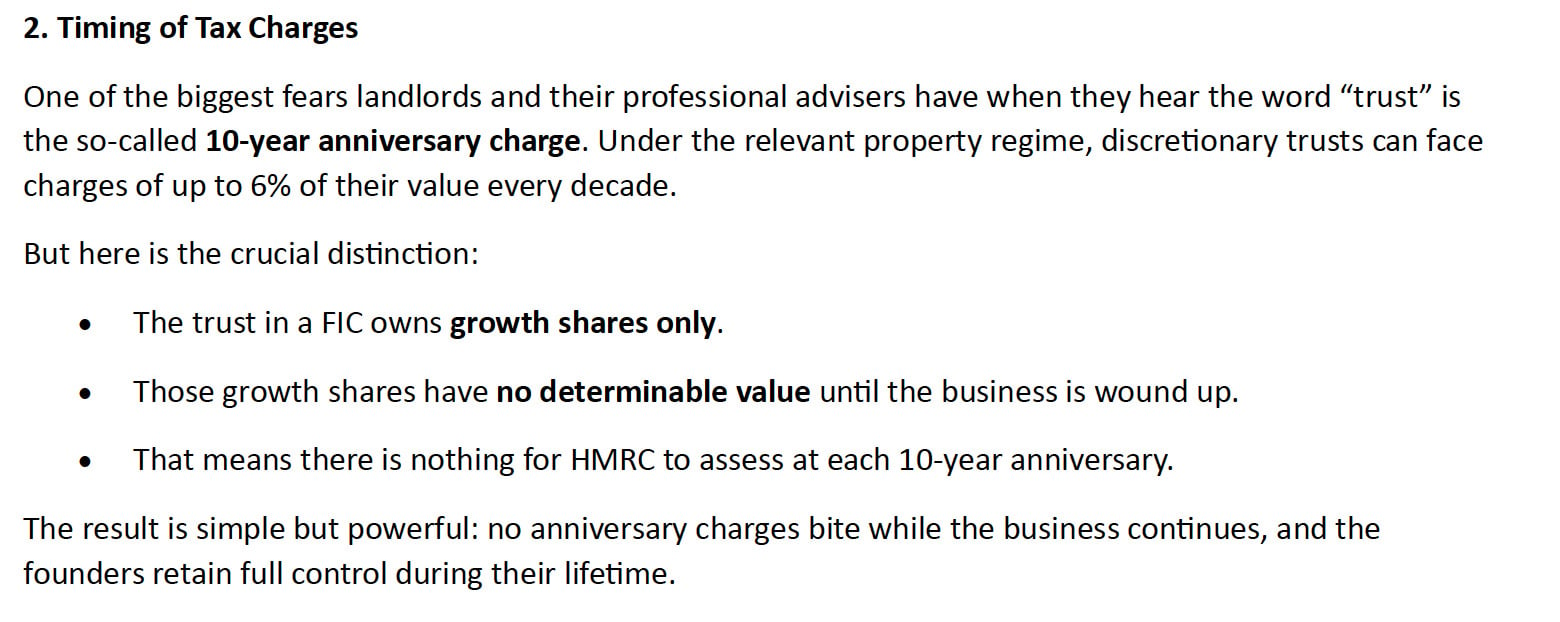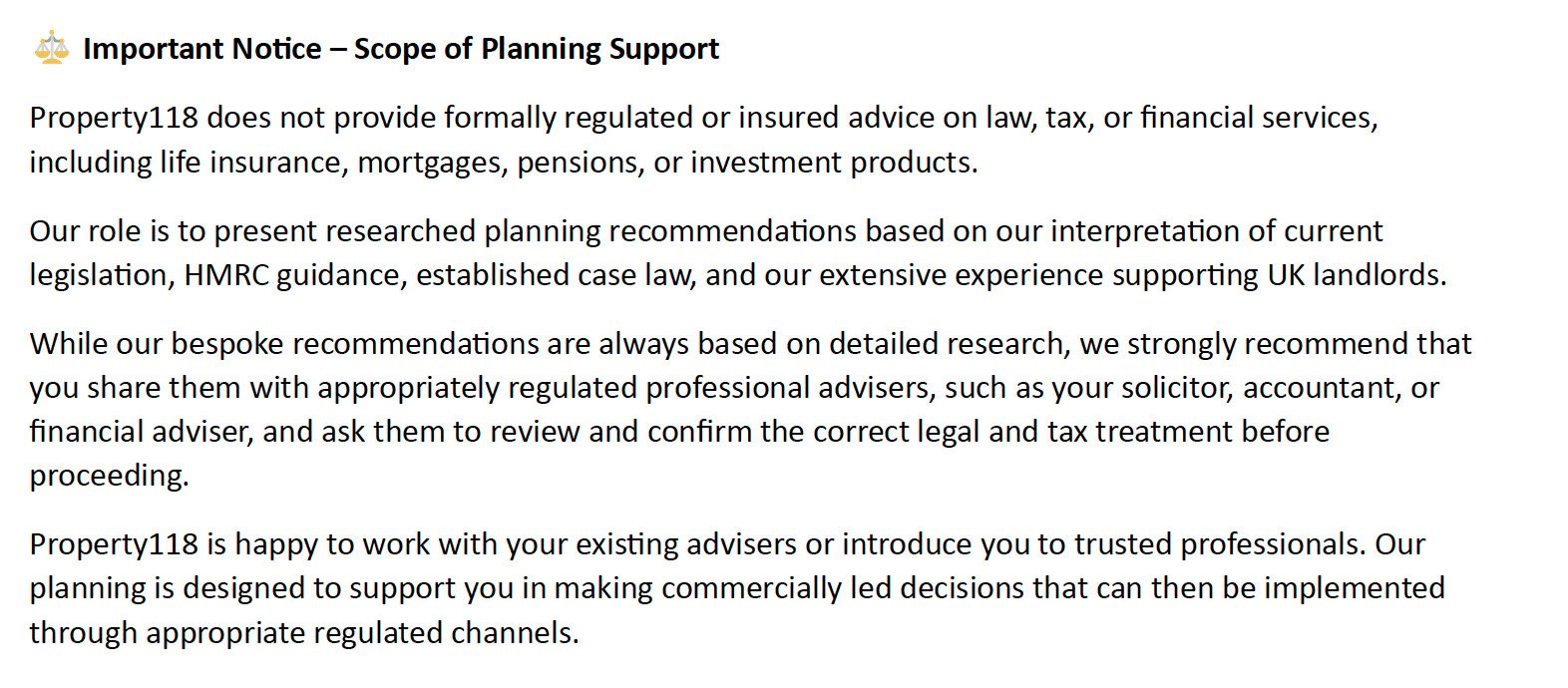Most of the HMRC losses from tax avoidance aren’t from multinationals or billionaires – they’re from small businesses, who’ve often been sold disastrous schemes by unregulated advisers. It’s a mis-selling problem as much as a tax problem. This report presents one example – but the internet is full of many, many others.
The media focus on inheritance tax has created an irresistible opportunity for unregulated tax firms. One of those firms is “Property118” – they market “family investment companies” to landlords as an inheritance‑tax magic bullet. But the structure is based on a basic misunderstanding of inheritance tax, and will leave many clients with six-figure tax bills – not when they die, but now.
This isn’t the first time Property118 has been caught selling a structure they don’t understand. We’ve written about them before, which resulted in HMRC issuing a “stop notice” to require that Property118 stop promoting their “substantial incorporation” scheme.
But the problem is much wider than one firm – this structure is being widely promoted to landlords, farmers and others. As long as tax advice is unregulated, HMRC will continue to lose tax revenue to technically hopeless avoidance schemes, and taxpayers will continue to get ripped off.1
Updated 8 October 2025 – we’ve now reviewed several sets of company articles drafted by Property118. The “growth shares” appear to have been badly mis-drafted. We’ve added a section below covering the consequences of that.
The Property118 growth share scheme
The scheme works like this:
- You have (say) a £5m property rental business in a company, and you’re worried about a £2m inheritance tax bill when you die.2
- The company issues you shares that give you complete control of the company, entitle you to all dividends, and entitle you to all the current £5m capital value of the business (so-called “freezer” shares).
- The company then issues your children with shares that entitle them to all capital growth of the company over £5m – “growth” shares.
- The growth shares are put into a discretionary trust that (in practice) gives you some assurance that the kids can’t run off with the shares, lose them in a divorce, etc.
We’ve saved a copy of the Property118 family investment company guide here.
Tax advisers often caution people against using trusts, because a gift into trust creates a “chargeable lifetime transfer” – inheritance tax at 20% of the value of the property put into trust (after the nil rate band), and the trust is then liable to a 6% “anniversary charge” on its value every ten years.
But Property118 and lots of other unregulated internet tax advisers have a neat solution – they say the “growth shares” have no current value – they only entitle your children to value over £5m, and the company is currently worth £5m. So the trust isn’t taxed:
That’s clear that this is an avoidance scheme. Value supposedly vanishes from the parents’ “freezer” shares, and thus their estate, without ever appearing and being taxed in the “growth shares”.
And, like most avoidance schemes, it doesn’t work.
Property 118 – the drafting errors
The original version of this report was written assuming that Property118 would correctly draft the articles of their family investment companies and the terms of the growth shares.
We have since (8 October 2025) reviewed several sets of Property118 documentation and that assumption appears to be incorrect. Here’s an anonymised version of one set of articles:
The “Q Ordinary shares” here are the non-voting growth shares. The “A Ordinary shares” and the “B Ordinary shares” are the freezer/voting shares. There are also non-voting shares C to P which can receive dividends.
The share rights work as follows:
- The shares are specified in Article 9.2 as “Each ‘Q’ Ordinary share carries no vote nor dividend right. Each ‘Q’ Ordinary Share is entitled to participate in a distribution on a sale or winding up of the company.”
- Article 9.4 then says “In the event that the proceeds are more than £900,000 the first £900,000 shall be distributed to the ‘A’ Ordinary shareholders and the ‘B’ Ordinary shareholders in proportion to the nominal value of shares held. Any proceeds in excess of £900,000 shall be distributed to the holders of the ‘Q’ Ordinary shares in proportion to the nominal value of shares held.”
- There is no definition of “proceeds” and no mechanism for paying any sale proceeds to the Q shareholders. Obviously the company can’t do this, as it doesn’t receive sale proceeds. Often there would be “tag-along” rights, which require that minority/non-voting shareholders participate in any sale – such provisions are absent.
- Article 9.5 says “Subject to the provIsIons of the Act, the directors may, in their absolute discretion, declare final and/or interim dividends on any class or classes of shares and when so declaring may vary the dividend payable between the different classes of shares and may determine that any class or classes may receive a dividend and that another class or classes shall not, and Article 30 of the Model Articles shall be modified accordingly.”
- There are none of the usual “class rights” one expects to see to protect the interests of minority or non-voting shareholders. The only protection they have are the statutory pre-emption rule and the statutory prohibition against amending class rights without the class’s consent.
This means that the holders of the A and B shares (the parents) can ensure all rent/profit and proceeds from any asset sales are paid out on their shares as dividends. The growth shares don’t receive a penny unless the A and B shares vote to wind up the company.
The A and B shareholders could go even further, and issue an additional 10,000 Q shares to themselves in consideration for £100 of gilts.3. The original Q shares would then receive only a thousandth of any eventual winding-up proceeds.4
The valuation specialists were split on whether this means the growth shares have no value at all during the life of the company, or in fact have some small residual value (essentially because they are a nuisance for the A and B shareholders).5
However it’s clear the growth shares leap in value upon any decision to wind-up the company at a point when it has over £900k of net assets. The leap in value is a result of that decision – and the decision will reduce the value of the A and B shares, and therefore the parents’ estates. It will therefore either be a straightforward transfer of value for inheritance tax purposes, or the issue of the shares and decision to wind up will be “associated operations” with broadly the same result. In either case there would be a “lifetime transfer” for inheritance tax purposes.6 As the Q shares held by a trust, it would then be a lifetime chargeable transfer giving rise to an immediate 20% inheritance tax charge (and more if the parents then die within seven years). The value-shifting rules will likely also apply and deem an immediate capital gains disposal by the parents, given they are taking an action which reduces the value of their holding.
This is all very bad result for Property118’s clients. The aim of removing value from the parents’ estate has not been achieved,7 and there will be an up-front IHT and CGT charge at the point value is paid out on the Q shares.
The inheritance tax and company law specialists we spoke to were split on whether the unusual terms of the Q shares are a mistake8 (e.g. drafted by someone who doesn’t understand how class rights work) or a (failed) attempt to find a loophole by deliberately creating valueless shares. Either way, the peculiar nature of the Q shares mean they are likely regarded as “contrived or abnormal” and therefore Property118 should have disclosed the structure under the Disclosure of Tax Avoidance Schemes (DOTAS) rules. We discuss the implications of that further below.
The remainder of this report will proceed on the basis that it was a mistake and that in at least some cases Property118’s structure has correctly drafted growth shares. The consequence of that is a worse tax result, including a large up-front tax liability.
Property118 – the valuation problem
The proposition that the growth shares have zero value is easily tested: would anyone holding them agree to sell for £1, or £1,000? Of course not.9
Or another way to test it: would a third party agree to buy the freezer shares for £5m, knowing there is no possibility of capital growth? Of course they wouldn’t.
The growth shares are a one-way bet: if the business increases in value, then the growth shares increase in value; but if it doesn’t then the growth shares can simply be discarded. An asset like that always has value (and always reduces the value of the freezer shares). The fact that the payoff from the growth shares is contingent on future growth doesn’t mean its present value is nil; it means its value must be discounted for risk and uncertainty.
Determining the value isn’t easy, but it’s not particularly hard either. Inheritance tax requires value to be determined by asking what a hypothetical purchaser would expect to pay in the open market. There are plenty of cases applying this principle, and it’s certainly HMRC’s approach.
There are several ways to value these kinds of shares. The most straightforward is to carry out a discounted cash flow calculation by looking at the different outcomes and weigh them by probability.
Here’s a simplified example.
An example DCF valuation
Looking at Property118’s own case studies, let’s take a property business worth £5m.
We need to start by calculating the expected value of the business after (say) ten years. Property118 say a “deliberately cautious” result would be a 6% compound growth rate:
Let’s assume there’s a 50% chance the business indeed experiences 6% compound growth each year. Then assume there’s a 25% chance the business doesn’t grow at all, and a 25% chance it grows by 8%. (It’s important to stress that this is a simplified illustrative example: a real valuation wouldn’t just pull three numbers out of the air.)
Let’s then assume value is realised on a sale/winding‑up in 10 years. That means there’s a 50% chance the business ends up being worth £9m10, a 25% chance it’s still worth £5m, and a 25% chance it’s worth £10.8m 11. A weighted average12 of those figures tells us the expected value of the business in ten years’ time is £8.4m. The growth shares will be worth that minus the initial £5m value – so the expected value of the growth shares in ten years’ time is £3.4m.
But we can’t stop there.
- The kids won’t receive that £3.4m for ten years, so we should discount the figure appropriately – money in the future is always worth less than money today, particularly if there’s a high risk the money won’t in fact be received. This is reflected in a “discount rate”. Because the growth shares are deeply subordinated and only participate in upside, their required return – and therefore the appropriate discount rate – must be higher than the expected growth rate of the underlying property business. If we use a 10% discount rate then that reduces the £3.4m figure by about 60%.13
- And the growth shares have no voting rights – often one would see a 10% discount for that.
- The growth shares are illiquid/aren’t marketable and (on our assumption) the holder won’t receive any return for ten years. We should apply a 25% discount for that.14
- These three factors together take the value of the growth shares to just over a quarter of their expected value in ten years’ time – £890k.15
So our conclusion is that the growth shares are worth approximately16£890k when they’re issued.17 Of course a real valuation would be much more sophisticated than this – but HMRC would expect to see a DCF valuation as part of the analysis.
We’ve put this example into a spreadsheet that you can download here.
Other approaches
There are other more sophisticated ways to value growth shares – for example treat them as a call option and use the Black‑Scholes equation. This will often result in a higher valuation than the simple approach above (although it’s more typically applied to listed than unlisted shares).
So for now let’s stick with our very simplified discounted cash flow valuation estimate for the growth shares: £890k at the point the company is established.18 The simplistic approach we took, and the lack of any real-world basis for our assumed growth figures, means that a defensible figure for a real £5m property business could absolutely be higher or lower; the point of our example is to demonstrate that it is not zero, and is plausibly around £1m.19
The consequences for Property118’s clients
That £890k value implies an unexpected up-front inheritance tax charge of £113k.2021
If the taxpayer dies within seven years then there will be additional inheritance tax to pay – it’s treated in much the same way as a gift (except that up to half the tax was up-front). If the taxpayer doesn’t die within seven years then there won’t be additional inheritance tax to pay – but if the taxpayer had simply made a gift to their children then there would have been no inheritance tax on it at all.
This is all a very bad result for a structure that’s marketed as saving inheritance tax. Worse still, Property118 seem to encourage people to move into these structures and incur large capital gains and stamp duty bills, all on the promise of an inheritance tax saving.
We expect that HMRC will open an inheritance tax enquiry into anyone setting up a family investment company with growth shares that were supposedly valued at zero. HMRC will, however, not be in a hurry because of the way time limits work for inheritance tax.
Someone making a chargeable lifetime transfer is required to report it to HMRC using form IHT100 (with IHT100a where appropriate). We expect Property118’s clients won’t submit a return – that means HMRC will have 20 years in which to investigate and assess inheritance tax.22 If a return was submitted then the usual limits apply, six years if a taxpayer was careless and four years otherwise.
The worst possible result is that HMRC don’t investigate until after the taxpayer dies – their children will then have to face an HMRC investigation at the worst possible time.23
HMRC is likely to seek to charge penalties on the basis that failing to carry out a proper valuation and/or submit a return was careless.
Property118 have variations on this structure which will likely trigger other adverse tax consequences for their clients:
- If value is shifted from founders’ shares to trust‑held growth shares via changes in share rights, the value-shifting rules can apply to deem a capital gains tax disposal by the founders. The claim in this Property118 case study that there’s no capital gains tax on the creation of growth shares is false. 24
- If there’s no trust, but growth shares are issued directly to a director’s children for less than market rate, the employment-related securities rules are potentially in point.
- Property118 sometimes advise that the family investment company should issue redeemable preference shares to the founders, and that these can later be redeemed free of capital gains tax. This is incorrect. After an s162 incorporation, the capital gain on the underlying property assets is “held over” into the preference shares, so disposal gives rise to a capital gain. But that’s the best case – if it’s a partial disposal (as the case study suggests) then the clients may well be subject to income tax (and not capital gains tax) under the transactions in securities rules.
There are also potential non-tax consequences: most importantly, anyone using the structure is likely to find it much harder to obtain loan finance.25
The long-term consequences
Trusts are subject to a 6% ten-yearly anniversary charge on the trust’s value above the available nil‑rate band. Property118 say this is a misconception:
There is no inheritance tax concept of “determinable value” – Property118 appear to have made it up. Even if the growth shares were hard to value, you’re still required to prepare a valuation. In reality, property is one of the easiest assets to value – much more straightforward than many trading businesses.
But at least Property118 mention the 6% anniversary charge – the 20% entry charge isn’t mentioned once in their brochure, and only incidentally on their large website.
We can estimate what the 6% ten-yearly charge will look like if we continue the approach in the DCF example above.26 On that basis, in ten years’ time the company’s property would be expected to be worth £8.4m, with the growth shares worth £2.4m. The ten year anniversary charge would be around £120k.27
There’s also a 6% charge on exit from the trust, broadly proportionate to the time since the last ten-yearly charge.
The other long-term consequence is that the arrangement has failed to cap the value of parents’ shares for their estate at £5m. If the property is worth £8.4m and the growth shares are worth £2.4m then it follows that the freezer shares28 and voting shares are together worth £6m, not £5m. Value can’t just disappear. How can mere voting shares become valuable? Because the holder of the growth shares needs the agreement of the holder of the voting shares to release value. The higher the discount we apply to calculate the value of the growth shares, the more value we push into the voting shares.29
That is a problem for the structure, because the voting shares are part of the parents’ estate. The whole point of the structure was to freeze the estate at £5m – but that ignored the power of the voting shares.
Is Property118 regulated or insured for tax advice?
Advisers like Property118 present technically wrong claims with great confidence.
The truth, however, is revealed, at the back of Property118’s brochure:
Property118 is unregulated and uninsured. They try to cover themselves by saying clients should ask their other advisers to “review and confirm” the correct legal and tax treatment. But note how the list of other advisers doesn’t include any qualified tax advisers.30
That leaves a Property118 client with no recourse if, as here, the tax advice is wrong. Worse, HMRC will likely charge penalties because the client was “careless” in relying upon an adviser who said they weren’t providing definitive advice.31
It’s possible Property118 misunderstood the outcome of the review of family investment companies which HMRC conducted in 2020 and 2021. HMRC concluded that they didn’t see a pattern of non-compliance, and saw no need for legislation. Some people saw this as the green light to use family investment companies for avoidance. That’s a bad mistake.
Whatever the reason for Property118’s errors, they’re mistakes which we don’t believe any competent adviser would make. Even ChatGPT identifies the problem when presented with one of Property118’s case studies.32
Are Property118 breaking the law?
In promoting the structure, Property118 may themselves have broken the law. The Disclosure of Tax Avoidance Schemes (DOTAS) rules require arrangements with a main benefit or purpose of obtaining a tax advantage to be disclosed up-front to HMRC. Property118 haven’t disclosed their structure under DOTAS; it’s unclear if they’ve ever properly considered the application of the rules.
The Property118 brochure says that DOTAS doesn’t apply because “HMRC has never issued a Disclosure of Tax Avoidance Schemes (DOTAS) reference number for FICs”. This is a sales pitch, not a legal analysis. Property118 can’t possibly know if the statement is true (only in some cases does HMRC publish avoidance scheme details). Even if it is, it gives no assurance that their structure isn’t subject to DOTAS.
We believe an actual application of the DOTAS rules shows that they probably do apply to the Property118 growth share structure:
- DOTAS applies to a structure if (broadly speaking) its main benefits include the obtaining of a tax advantage and the scheme has one or more designated “hallmarks”.
- It’s clear from the brochure that one of the main benefits is IHT mitigation.
- The inheritance tax hallmark is likely to apply – the brochure shows that the scheme’s main purposes include obtaining a tax advantage, and the creation of the “growth” and “freezer” shares, and issuance at an undervalue, are likely “contrived or abnormal” steps (although we wouldn’t say that point is beyond doubt).
- The premium fee hallmark may also apply. This is a reasonably simple structure, so when the brochure says Property118’s fees are “in the low-to-mid five-figure range”, it suggests to us that the fees in part reflect the (supposed) tax benefit.
- The confidentiality hallmark seems unlikely to apply unless there are features that are not being included in the brochure and published case studies.
It follows that the likely conclusion is that the structure should have been reported.33
If that’s correct, then Property118 are likely to incur penalties of £600 per day, which a tribunal can potentially increase to a maximum of £1m.
How the pros do it
“Growth shares” are a real thing. They’ve been issued by companies for decades as part of employee share schemes; they are also used by properly advised family investment companies.
There are, however, two big differences between real growth shares and the scheme being sold by Property118:
- Real “growth shares” usually have a “hurdle” which is higher than the current market value of the business. They don’t entitle the holder to all value above today’s valuation of the business, but to all value above the hurdle. For example, the hurdle could be set at 25% above the current value of the business, with the growth shares entitled to all growth above (on our example figures) £6.25m. That greatly reduces the initial value of the growth shares.34
- Real tax advisers ensure there’s a proper valuation of the growth shares (here’s a good guide from accounting firm Price Bailey), using the kinds of approaches we summarised above. The unregulated advisers like Property118 don’t do this because they’re salesmen rather than qualified tax advisers, and are in search of a magic bullet that takes all future growth out of inheritance tax.35
There has been a surprising widespread practice of people trying to argue that growth shares with a hurdle have no day one value at all. That’s a much better structure than Property118’s but, as other commentators and advisers have noticed, it’s still not defensible (at least not without very careful and detailed valuation advice). HMRC fired a warning shot at the profession at a forum for advisers in September 2023, and we don’t expect there are many bona fide advisers still running this kind of argument.
Given the hurdle shares still have value, there are various strategies advisers use to prevent an up front chargeable lifetime transfer. Most obviously it’s making sure the economics are such that the value is less than the nil rate band. Sometimes it involves structural solutions, such as the trustees using loans to acquire the trust interest – but that gets into quite difficult territory, and potentially into avoidance, with all the consequences that follow from that.
We’re not aware of any real advisers claiming that growth shares just don’t count for purposes of the ten-yearly anniversary charge, because they “have no determinable value”. Property118 just made that up.
Given the popularity of naive “growth share” structures, it may make sense for HMRC to publish a Spotlight warning people of the risks.
The problem of unregulated advisers
The government is moving to regulate the tax‑advice market, but the scope is narrow. New rules will require tax advisers who interact with HMRC on clients’ behalf to register with HMRC and meet minimum standards from April 2026 (with a short transition). HMRC’s aim is to control access to its systems and exclude agents who fail its “Standards for Agents”.
But this regime only applies to people who act as agents with HMRC. It doesn’t cover consultancies that design and sell structures but leave tax returns and HMRC engagement to the client’s usual accountant. That means many unregulated promoters, like Property118, will likely sit outside the new registration requirement. Indeed they’ll have a competitive advantage over firms that have to be regulated.
So we’re concerned the new regulation will create bureaucracy for small firms that aren’t doing anything controversial, but won’t impact bad actors.
Who should landlords turn to for advice?
Landlords, and anyone else needing tax advice, should use a regulated firm, and only deal with regulated professionals. If you’re speaking to a salesman, with no legal or tax qualifications, then our view is that you’re making a mistake, and potentially a very expensive one.
You can check online if an adviser or their firm is regulated (either is fine). The main regulators are:
- Solicitors Regulation Authority
- Chartered Institute of Taxation
- Association of Tax Technicians
- Association of Chartered Certified Accountants
- Institute of Chartered Accountants of Scotland
- Institute of Chartered Accountants in England & Wales
Experience is also important. We’d suggest only using an adviser who’s been practising for at least ten years, or is supervised for a senior colleague who has that experience.
Any regulated adviser should carry insurance, but it’s good to check this. Although note that the insurance does not simply pay out if something goes wrong; you would have to experience a loss, sue the adviser for negligence and win – the insurance then pays out, so you’re not limited to the funds available to the adviser/firm.36
Many thanks to R for the original tip, to S for their inheritance tax expertise, and to K and F for their valuation insights.
Photo by Louis Reed on Unsplash
Footnotes
Note that it’s not either/or. We don’t believe any of the schemes we’ve reported on would survive HMRC challenge. However some schemes will “fly under the radar” and never be subject to an HMRC enquiry. Others will be subject to an enquiry, but HMRC will make a mistake, miss a deadline, or the taxpayer will win on a procedural point. So these schemes have two effects at the same time: loss of tax when HMRC fails to effectively challenge a scheme, and ripped off clients when HMRC does effectively challenge a scheme. ↩︎
That’s looking only at the company; presumably there’s also a house and other assets, probably partially covered by the nil rate bands. ↩︎
Gilts rather than cash so the statutory pre-emption rule doesn’t apply. It could be book tokens – any valuable non-cash consideration would suffice. ↩︎
If done at a time when the Q shares were valuable then this could be challenged as unfair prejudice. However, for the reasons we mentioned in the previous paragraph, it’s debatable if the Q shares can ever be valuable. A challenge seems unlikely to succeed, particularly if the new shares were issued at an early stage, when the company is still at the £900k threshold. And this isn’t a variation of class rights, so section 630 won’t apply. ↩︎
For example: winding-up could be more tax-efficient than paying dividends, as it enables capital gains treatment and a lower rate. So perhaps the A and B shareholders would agree to pay the Q shareholders some portion of their tax saving to entice them to agree to a compromise deal. It’s this kind of scenario which is why some of the valuation specialists we spoke to thought that the Q shares could have value in some scenarios – but not much. ↩︎
Section 94 IHTA wouldn’t apply because it’s a transfer of value by the A and B shareholders, not the company. ↩︎
Some people may object that the A and B shares are held by the parents, and they wish the Q shares to have value. That’s irrelevant for IHT purposes; the question is what value the Q shares would have in a market sale to a willing buyer. We can’t assume the parents would be doing that buyer a favour. ↩︎
That’s plausible; Property118’s previous tax scheme suffered from incompetent drafting – with one bad drafting error replicated throughout (we believe) all their clients’ documents, which has left those clients in a very difficult position. ↩︎
Even in the “mistake” scenario above, the growth shares have nuisance value. ↩︎
i.e. £5m x 1.06 ^ 10. ↩︎
i.e. £5m x 1.08 ^ 10. ↩︎
i.e. 50% x £9m + 25% x £5m + 25% x £10.8m. ↩︎
i.e. because 1/(1.10 ^ 10) = 0.39. The level of a discount rate is often a key area of dispute between taxpayers and HMRC – taxpayers arguing for a high discount rate reflecting the high risk and subordinated nature of the growth shares. HMRC responding that it’s appropriate for a relatively low-risk asset like a property rental business, where much of the “growth” is just compounding rents. The valuation specialists we initially spoke to felt that 7% was a reasonable number for this example, given that most of the capital growth would be compounding rents. Others thought a higher figure was more appropriate. We have therefore amended this report post-publication to show a 10% rather than 7% rate – the issues are the same regardless. ↩︎
Important not to double count here; if a higher discount factor was used which reflected illiquidity then one wouldn’t also apply an illiquidity discount. ↩︎
£3.4m x 0.39 x (1- 10%) x (1 – 25%). ↩︎
Valuation is often said to be an art rather than a science – there will be a range of possible values. ↩︎
We’re assuming no dividends are paid on the “freezer” shares, i.e. no “dividend bleed”. Any expected dividends would reduce the expected growth and therefore the expected value of the growth shares. ↩︎
Note that it follows that the “freezer shares” retained by the parents must be worth something like £4.11m – i.e. the £5m value of the property portfolio less the value of the growth shares. Property118 assume that the freezer shares must be worth £5m, but a moment’s thought shows that this isn’t correct – real estate is much less valuable if the potential for capital growth is eliminated. ↩︎
The discount rate has a huge impact on the result. It will reflect the level of risk in the business – the type of properties and (importantly) the level of debt/leverage. To give an idea of how the discount changes the result, on our assumptions a 5% discount rate implies the growth shares are worth £1.4m; a 9% discount rate implies they’re worth £1m. Only if the discount rate reaches an implausible 22% does the value of the growth shares drop below the £325k nil rate band, and the structure “work”. You can play with the discount rate and all the other assumptions in the spreadsheet. ↩︎
20% of a chargeable lifetime transfer of £565k (£890k after deducting the £325k nil rate band). That’s assuming it’s the trustees that pay; if the settlor pays, the tax has to be grossed-up. Note that IHT will arise whether the shares are given directly by the parents to their children, or the company issues them. ↩︎
Another consequence: the taxpayer has used up their £325k nil rate band. The impact of this can be quite complex; there’s a 14-year look-back if a chargeable transfer into a trust is followed by a potentially exempt transfer within seven years, and then death within seven years of that. ↩︎
The long limit is a consequence of the very long-term nature of inheritance tax planning. ↩︎
If the properties have in fact significantly gone up in value then HMRC is likely to be more aggressive in pushing for higher day-one valuations. In principle valuation should not be affected by hindsight; in practice matters are less clear-cut. ↩︎
Although note that if there is both a CGT charge and an IHT charge then an election can potentially be made for the CGT to be “held over“, i.e. deferred until the trust disposes of the shares. So in most cases there wouldn’t be a simultaneous CGT and IHT charge on the same disposal. The potential “gotcha” for users of tax schemes is that if HMRC take years to raise an enquiry, then the taxpayer may be out of time to make an election, and so could face double taxation. ↩︎
Because lenders to property companies typically require share security over the property. Having split share classes, and one class held by a trust, is a practical and legal complication which many lenders will not accept. The structure is therefore likely to dramatically reduce the pool of potential lenders. ↩︎
i.e. if we calculate the expected value of the company after ten more years. The expected year‑20 payoff is then discounted back 10 years, then adjusted for non‑voting and illiquidity, in the same way as we valued the shares for day one. ↩︎
£2.4m minus £325k x 6%. ↩︎
As noted above, the “freezer” shares will be worth less than £5m because they are an interest in property without any upside (albeit they have some “downside protection”). ↩︎
HMRC are well aware of the valuation issues caused by special classes of voting shares. ↩︎
And when proper tax advisers have historically challenged tax planning from the likes of Property118, the response has often been derision and bullying. ↩︎
See the Lithgow and Anderson cases, e.g. “Nor would we expect such a taxpayer to obtain another professional opinion again unless there is reason to do so, of which the taxpayer ought to reasonably be aware, such as that any qualification put upon the advice by the firm may limit its reliability”. ↩︎
As an aside, it’s a very bad idea to use ChatGPT or other LLMs for tax advice, but a good idea to use them to see if a point has been missed, provided you treat all output with scepticism and check primary sources with great care. ↩︎
Something Property118 have misunderstood in the past is that whether DOTAS applies is separate from whether a scheme works. This scheme fails whether or not DOTAS applies to it. In principle a scheme could succeed even though DOTAS applies to it (although that would be a rare case these days). ↩︎
On our example numbers, a 25% hurdle would cause the initial value of the growth shares to fall by more than 50%. A 50% hurdle – an entitlement to all growth above £7.5m – could cause the growth shares’ value to fall to almost nothing. Noting again that our assumptions and valuation methodology is just illustrative, and any assertion of negligible value would likely be contested by HMRC. But it’s completely realistic that in some cases the value would end up less than the nil rate band. ↩︎
The brochure talks about the importance of valuation in relation to the property portfolio itself, but shows no awareness that the growth shares themselves need to be valued. ↩︎
A common habit of disreputable advisers is misrepresenting insurance as if it’s an automatic payout if HMRC challenge the structure. ↩︎







Leave a Reply to Michael Stannard Cancel reply